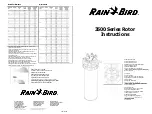
99
Appendices
Note messages
✩
These messages convey notes played on the keyboard. They include the following
information.
Note number:
a number indicating the note (key) that was pressed or released
Note on:
data indicating that the note (key) was pressed
Note off:
data indicating that the note (key) was released
Velocity:
a number indicating how strongly the note (key) was pressed
Note numbers are a number from 0 to 127 which indicate the key-
board key position, with middle C (C4) as note number 60.
Pitch Bend
✩
This is used to transmit message about the operation of the pitch bend wheel (or lev-
el) usually found on synthesizers. Pitch benders can continuously change the pitch
of a note over a wide range.
Program Change
✩
These messages are used to select sounds. Sounds are selected by a Program num-
bers 1–128. On the SC-8820, these messages will select sounds (Instruments). By us-
ing Bank Select messages (which are a type of Control Change message), an even
wider variety of sounds can be selected (p.22).
Control Change
✩
These messages control parameters such as modulation and pan. The function of the
message is determined by its Control Change number.
Bank Select (control change number 0/32)
The tone is changed when used with a Program Change message. The tone is select-
ed with a Program Change message after selecting the Bank Select message.
The sound will not change when only a Bank Select message is received.
Modulation (control change number 1)
✩
This message controls vibrato.
Volume (control change number 7)
✩
This message controls the volume of a Part. When this message is received the vol-
ume of a Part will change.
Expression (control change number 11)
✩
This message conveys volume changes. It can be used to add expression during a
song.
Using Volume and Expression
It is convenient to use Volume and Expression in distinct ways, as follows.
Volume:
Adjust the volume balance between Parts.
Expression: Create volume changes during a song (crescendo, decrescendo, etc.)
The reason for this differentiation is that if you use only Volume messages to create
volume changes during the song, you will have to modify all of the Volume data in
the song if you later decide to adjust the volume balance between the Parts. Howev-
er, if you use only Volume at the beginning of the song, and use only Expression dur-
ing the song, it will be easy to adjust the volume balance between Parts for the entire
song simply by modifying the Volume data at the beginning of the song, and the
data for changes in dynamics during the song can remain as it was. This is very con-
venient when, for example, you decide to make a slight change in the balance be-
tween the piano and bass when the song is nearly completed.
On some MIDI sequencers,
control change data located
at the same step (timing) is
transmitted in ascending
order of controller number.
If you are using this type of
MIDI sequencer, you must
adjust the timing of the
bank select data so that it is
always transmitted in the
correct order of Bank Select
→
Program Change.
The volume of a Part will
be affected both by Volume
messages (control change
7) and by Expression
messages (control change
11). If a value of 0 is
received for either of these
messages, the Part volume
will be 0 and will not rise
even if the other message is
sent with a higher value. Be
aware of this.
Summary of Contents for Sound Canvas SC-8820
Page 2: ......
















































